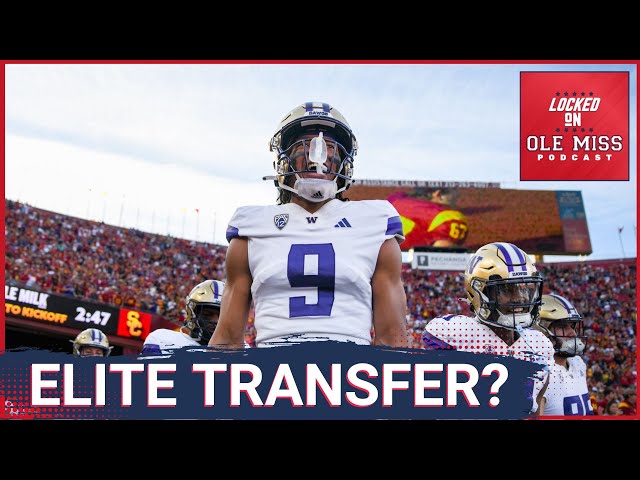Ole Miss Rebel to loose another young talented star to the Transfer Portal….
The Ole Miss Rebels are once again facing a tough reality: another young and talented player is entering the Transfer Portal. This is becoming a familiar story for the Rebels, as more and more promising athletes leave the program in search of new opportunities elsewhere. While the reasons behind these departures are often varied, the impact on the team’s future is undeniably significant.
In recent years, the rise of the Transfer Portal has shaken up college sports in a way that no one could have predicted. Players now have the option to leave their current program and explore opportunities at other schools without sitting out a year. While this has provided athletes with greater freedom and flexibility, it has also led to a growing sense of instability among many college teams. Ole Miss, a university that has seen its fair share of success in recent years, has not been immune to the trend of players transferring out.
The loss of a young talent to the Transfer Portal is especially hard to stomach for Ole Miss fans and coaches alike. These athletes, who often come in with high expectations and promise, represent the future of the program. The idea of losing them so early in their college careers suggests a deeper issue at play, one that is likely contributing to the trend of players leaving the program. The reasons for these departures are varied—some may be driven by a desire for more playing time, while others might be seeking a better opportunity for personal or athletic development. Some might leave due to dissatisfaction with coaching staff or a desire to play in a different system.
In the case of the latest player to enter the Transfer Portal, the timing couldn’t be worse for Ole Miss. With several key pieces of the team still in flux, losing another young player to the portal leaves the Rebels scrambling to fill holes and maintain the momentum they’ve built over the past few seasons. This player, who had been viewed as a potential cornerstone for the team’s future, represented the type of talent that can be the difference-maker in a competitive SEC environment. His departure not only weakens the current roster but also raises questions about the long-term stability of the program.
It’s clear that the landscape of college sports has shifted, and programs like Ole Miss are forced to adapt to a new reality. Gone are the days when a player would commit to a school and stay for four years, barring injury or other extenuating circumstances. The Transfer Portal has made it easier for athletes to test the waters and find new homes if they feel that their current situation isn’t ideal. This isn’t necessarily a bad thing, but it does create a level of uncertainty for coaches and fans who have come to expect continuity and stability from their teams.
For Ole Miss, the question is whether this trend will continue or if they will find a way to retain their young talent. The Transfer Portal has become a double-edged sword for many programs: while it allows schools to bring in talented players from other programs, it also opens the door for their own stars to leave. This creates a cycle of roster turnover that can be difficult to manage, particularly for teams that rely on developing young talent over time.
One thing that is clear, however, is that Ole Miss will need to adapt quickly if they hope to compete at the highest level. The SEC is one of the most competitive conferences in college sports, and programs that aren’t able to hold onto their talent risk falling behind. The Rebels have shown flashes of brilliance in recent years, but they’ll need to find a way to maintain that success while keeping their core players intact. This may mean addressing issues within the program, whether they relate to coaching, player development, or the overall culture.
At the same time, the reality is that the Transfer Portal is here to stay, and Ole Miss will have to learn to navigate it. Coaches will need to build relationships with their players in a way that encourages loyalty and commitment while also being mindful of the opportunities available to athletes outside of their programs. The Transfer Portal has made it easier for players to leave, but it has also made it easier for coaches to bring in reinforcements from other schools. If Ole Miss can manage their roster effectively and continue to recruit high-quality players, they can weather the storm and continue to be a competitive force in the SEC.
However, that will require a concerted effort from everyone involved. Coaches will need to develop a strong recruiting strategy that not only attracts top talent but also convinces them to stay for the long haul. At the same time, they’ll need to build a culture that values loyalty and development, so that players feel invested in the team’s success and want to see it through. If they can strike the right balance, Ole Miss may be able to build a program that is not only successful in the short term but also sustainable over the long haul.
In the end, the loss of another young player to the Transfer Portal is a tough pill to swallow for Ole Miss, but it is also a reality that many college programs are facing. The Transfer Portal has fundamentally changed the landscape of college sports, and teams like Ole Miss will need to adapt if they want to remain competitive. It’s a challenge, but one that the Rebels can overcome with the right approach. The question is: will they be able to keep their talent long enough to see the results of their hard work pay off? Only time will tell, but for now, the Rebels will have to move forward and find a way to fill the void left by yet another talented player who has decided to seek opportunities elsewhere.



